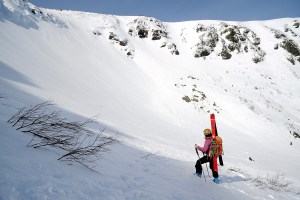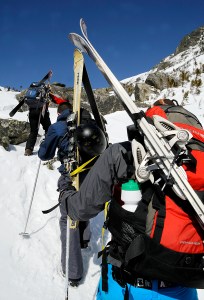TUCKERMAN RAVINE, MT. WASHINGTON, N.H. — There’s something about being able to reach out in front of you, while standing or tipping forward at a slight angle and touch the slope you are about to ski on.
The sustained steepness of the snow slopes in Tuckerman Ravine are unrivaled in the eastern United States and they are a mere 80 miles from Lewiston.
A descent there by board or skis — where one missed or bumbled turn can result in a cart-wheeling tumble of up to 1,000 feet — gives one pause … but also an exhilarating experience when completed successfully, which is the preferred method.
No double-diamond slope in New England can match the challenge, especially since the only way to get there is on your own two little feet. No ski lifts. No rope tows. Just a hard climb and the amazing payoff.
Even if you don’t ski, nothing beats basking in the sun on the slopes of these high mountains on a warm spring day after a heart-thumping hike. You can simply enjoy the neck-craning views of the ravine and the skiers. Relax, sit back and watch the show go down.
Whether you ski or not, the hike to the ravine in the spring is well worth the effort.
Here are two basic ways to visit Tucks in the spring.
Hard-core extreme — overnight camping
1. Fundamental: Bring common sense and flexibility. The conditions cannot be predicted.
2. Bring backup clothing. Include extra under layers and extra socks. Remember “cotton kills”; synthetic or wool are better options for staying warm, particularly if you’re likely to get wet from sweating, snow or rain.
3. To stay overnight it’s best to arrive early at Pinkham Notch Visitors Center on a weekend. If you can get there early Friday or even Thursday in the spring, you’ll enhance your chances of securing a spot in a lean-to. The weather even in summer can be downright cold on Mount Washington. In the spring, overnight temperatures will likely be freezing or below. Be ready. A cold-weather sleeping bag, rated to at least 0 degrees, is a good call. A ground tarp and sleeping pad are also nice to have.
4. Bring a basic first-aid kit and a cell phone. Regarding the phone: It’s not for chatting with Aunt Nancy while hiking; save your battery for an emergency. There is no easy place to recharge.
5. Bring a stove for heating water and food. There are no camp fires allowed, so a back-packing-style stove and enough fuel for your trip is a good plan. Lightweight and packable back-packing meals are good option. And lots of nuts, granola and some hot beverages of choice — think decaffeinated for staying hydrated and warm. Pack as light as you can, but be sure to have at least one extra emergency meal for each person in your trip.
6. Bring sun block, a good hat and sunglasses or goggles.
7. Bring money. It’s $10 a person per night if you plan to stay in a lean-to or on a tent platform. This is the camping fee you must pay when registering with the Appalachian Mountain Club either at Pinkham Notch or with the caretaker at Hermit Lake. Two nights is a decent overnight effort — the longer you stay the more gear you will need to lug in and lug out. Also consider consuming all the food and beverages you drink to lighten your load; all trash and leftovers must be packed out.
Daytripping
1. See numbers 1, 2, 4 and 6 above.
Get an early start and be prepared to spend at least 2 hours hiking to Hermit Lake from the visitors center on the way in and 1.5 hours from Hermit Lake on the way out. The hike from Hermit Lake to the floor of the ravine is another .7 miles and at a conservative pace, it takes about 40 minutes. The hike up the ravine to ski runs will varying depending on the route or the ability of the hiker and climber.
SAFETY, SAFETY, SAFETY
This applies to both daytrippers and campers.
1. Look before you leap and ask for information.
On the weekends there are plenty of trained people around at Tuckerman Ravine, including volunteers from the Mount Washington Volunteer Ski Patrol and the U.S. Forest Service’s full-time snow rangers. These people have knowledge about where the safest areas are and what might be a good option depending on your ability and fitness level. Collectively they have hundreds of years of experience and check the snow and weather conditions daily. They will be your best source for up-to-date avalanche, ski and climbing conditions.
2. Do not travel alone: If you become lost, do all you can to stick together. This will make finding you and your bodies easier should something go awry.
3. Do not underestimate the danger of a trip into an alpine environment. The list of people who have died on the mountain is on a plaque inside the AMC caretaker’s cabin at Hermit Lake. Before heading to the floor of the ravine stop and pay homage, and also use the moment to think about not becoming the next name scribed on the memorial.
4. Do what you can to help, if needed, lend a hand to fellow hikers and skiers, and also to rescue staff as they request it. Often, the best thing you can do to help is to not become another problem in need of help. But also know that help is available, and even the most well-equipped and experienced mountain travelers will have accidents and mishaps. Be humble.
HOW TO GET THERE
From the L-A area, head to Bethel and take Route 2 to Gorham, where you’ll pick up Route 16 south. Go for about 10 miles, past Wildcat and Great Glen, and look for the Pinkham Notch Visitor Center on the right. If you need a last-minute stop for supplies, anything you need can be found in Gorham, N.H. Pizza shops, camping supplies, beer and wine, batteries and food can all be found there. There are too many good merchants in town to just list a few here. Also for a healthy meal before or after your adventure try the Appalachian Mountain Club’s cafeteria at the Pinkham Notch Visitor Center, where you will park to access the trail to Tucks. The AMC also has a well-stocked store with hiking and camping goods as well as books, maps and other goods.
To see a video from the Sun Journal’s visit to Tuckerman Ravine online, go to www.sunjournal.com.
For more information about snow and avalanche conditions at Tuckerman Ravine online go to: www.tuckerman.org.
For information about current avalanche and snow conditions by phone call the U.S. Forest Service info hot-line at: 603-466-2713 or TTY 603-466-2856.



Comments are no longer available on this story